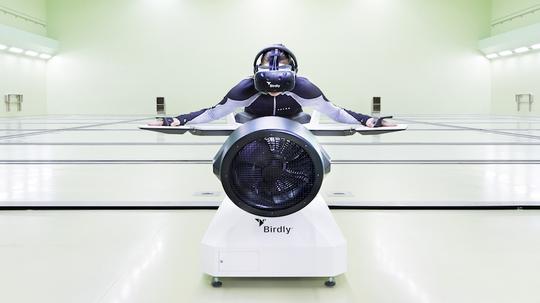
For a minute last Thursday, I was flying over New York City. Distracted by the Chrysler building down the block, I adjusted the tip of my right wing a little too far, overcompensated by flapping my wings like a maniac, and went crashing into a nearby building.
No worries, the Birdly operators assured me, we’ll just restart the program.
For that minute, I was experiencing Birdly, a new virtual reality experience that simulates a bird flying through a city, distributed by Evanston-based D3D Cinema and created by Switzerland-based Somniacs, which was demonstrated at the Field Museum this week.
Unlike an Oculus or HTC Vive, the $190,000 virtual reality machine isn’t going to be heading to a living room near you anytime soon. But D3D Cinema believes high end VR systems like Birdly could be an increasingly enticing product for museums, institutions and even the growing number of VR arcades.
Birdly is far more immersive than your typical VR headset. You lie flat on your stomach, arms outstretched, with a VR headset and headphones strapped on your head. You can either soar, tipping your arms to change directions, or flap your “wings” to move faster through the city, all while a fan blows wind in your face. The experience is set in either New York City or San Francisco (with more cities to come), but do be aware the buildings, while virtual, are real—if you crash, like I did, it's game over.
It was remarkably realistic and responsive—I felt an internal thrill soaring around skyscrapers and made a sharp dive into the city’s narrow streets. And while just the thought of swooping around city streets may make one’s stomach drop, I didn’t experience the same nausea I’ve felt from the same amount of time using an HTC Vive, Samsung Gear, or Oculus. Though I did feel a bit dizzy as I re-entered life on the ground back in the museum.
"It’s a physically involving, and exhausting, experience if you go too long," said Don Kempf, president and founder at D3D Cinema.
Birdly New York Experience from SOMNIACS on Vimeo.
It’s not cheap for institutions to purchase, but it’s not a particularly expensive add-on to a museum trip for a parent (museums charge $8 to $10 for a 3 minute experience). So far D3D Cinema has installed two machines, but Kempf said they're in talks with dozens of potential clients, mostly from high volume institutions such as science, tech and natural history museums, as well as zoos and aquariums. They're developing new full-body experiences as well, potentially embodying a flying pterosaur or a manta ray.
While Birdly was first developed in 2013 as a design research project at the Zurich University of the Arts, it morphed into VR and robotics startup Somniacs as Birdly's tech took off. For distribution help, Somniacs turned to D3D, which has deep experience in the cutting edge of cinema experiences.
D3D is actually the sister company to Giant Screen Films, a film production company started by Kempf in 1997 that specialized in documentaries for--you guessed it--giant screens in museums and other institutions. In 2007, looking to push showings of their a documentary on mummies that traveled alongside a popular King Tut exhibit, they started building digital 3D-friendly large format theaters in museums that didn't yet have the tech. Thus, D3D Cinema was born, and they've built or converted over 48 theaters internationally to date.
They're also behind the world's first "giant dome cinema laser system" along with digital cinema company Christie, a three-projector, laser-illuminated projection system that offers expanded colors and resolution. The system first launched at Cleveland's Great Lakes Science Center and a theater with the same tech will open at the Museum of Science and Industry this May.
Kempf said he doesn't expect that giant screen films are going away, but he does anticipate that VR experiences like this could be used to complement static exhibits and big screen experiences. The Field Museum, for example, is currently showing "Earthflight 3D" which takes viewers along with a flock of migrating birds. And with Birdly, the museum visitor actually becomes a bird.
"VR is on the cutting edge of technology, just like IMAX and giant screen technology was when it was first rolled out in the 70s and 80s," Kempf said.








